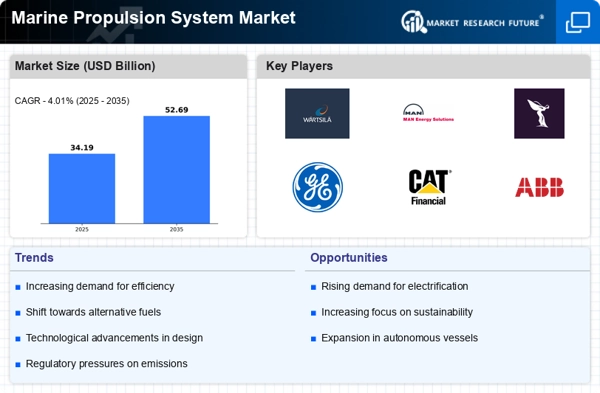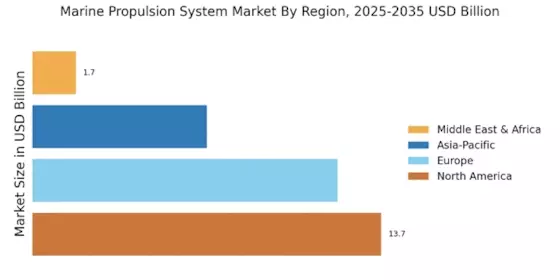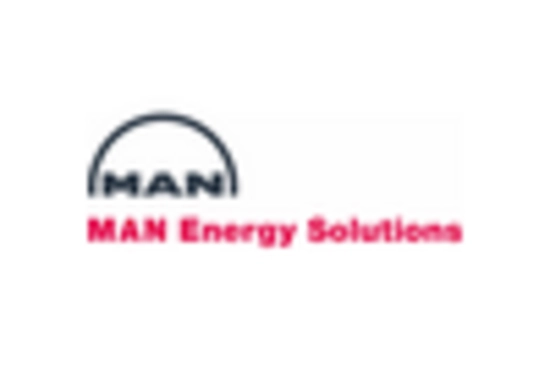Government Initiatives and Funding
Government initiatives and funding are crucial factors influencing the Marine Propulsion System Market. Many governments are actively promoting the adoption of cleaner and more efficient marine technologies through subsidies, grants, and research funding. These initiatives aim to reduce greenhouse gas emissions and enhance energy efficiency in the maritime sector. For instance, several countries have launched programs to support the development of alternative fuel technologies, such as hydrogen and biofuels, which are expected to play a significant role in the future of marine propulsion. Additionally, regulatory frameworks are being established to encourage innovation and investment in sustainable solutions. As a result, the Marine Propulsion System Market is likely to experience accelerated growth, driven by these supportive policies and financial incentives.
Rising Fuel Prices and Operational Costs
Rising fuel prices and operational costs are compelling factors driving change in the Marine Propulsion System Market. As fuel prices fluctuate and operational expenses increase, marine operators are seeking more cost-effective propulsion solutions. This trend is prompting a shift towards energy-efficient technologies that can mitigate fuel consumption and reduce overall costs. The adoption of alternative fuels, such as LNG and hydrogen, is gaining traction as a viable solution to address these challenges. Recent analyses suggest that vessels utilizing LNG propulsion can achieve up to 30% lower fuel costs compared to traditional marine fuels. Consequently, the Marine Propulsion System Market is adapting to these economic pressures, fostering innovation and the development of more efficient propulsion systems that align with the financial interests of operators.
Increasing Demand for Sustainable Solutions
The Marine Propulsion System Market is witnessing a pronounced shift towards sustainable solutions, driven by heightened environmental awareness and regulatory pressures. As nations implement stricter emissions regulations, the demand for eco-friendly propulsion systems is surging. This trend is evidenced by the growing adoption of hybrid and electric propulsion technologies, which are projected to capture a significant market share. According to recent data, the market for electric marine propulsion systems is expected to grow at a compound annual growth rate of over 15% in the coming years. This shift not only aligns with global sustainability goals but also offers economic advantages, as operators seek to reduce fuel costs and enhance operational efficiency. Consequently, the Marine Propulsion System Market is evolving to meet these demands, fostering innovation and investment in cleaner technologies.
Expansion of Maritime Trade and Transportation
The expansion of maritime trade and transportation is a key driver for the Marine Propulsion System Market. As global trade continues to grow, the demand for efficient and reliable marine transportation solutions is increasing. The International Maritime Organization has projected that the volume of goods transported by sea will rise significantly in the coming years, necessitating the development of more advanced propulsion systems. This growth is particularly evident in emerging markets, where infrastructure development is facilitating increased shipping activities. Consequently, shipbuilders and operators are investing in modern propulsion technologies to enhance their fleets' capabilities. The Marine Propulsion System Market is thus positioned to benefit from this trend, as stakeholders seek to optimize their operations and meet the rising demand for maritime services.
Technological Advancements in Propulsion Systems
Technological advancements are playing a pivotal role in shaping the Marine Propulsion System Market. Innovations such as advanced engine designs, automation, and digital monitoring systems are enhancing the performance and reliability of marine vessels. The integration of artificial intelligence and machine learning into propulsion systems is enabling predictive maintenance, which can significantly reduce downtime and operational costs. Furthermore, the development of more efficient propellers and hull designs is contributing to improved fuel efficiency. Recent studies indicate that these advancements could lead to a reduction in fuel consumption by up to 20% for certain vessel types. As these technologies continue to evolve, they are likely to attract investment and drive growth within the Marine Propulsion System Market, positioning it for a more competitive future.


















Leave a Comment